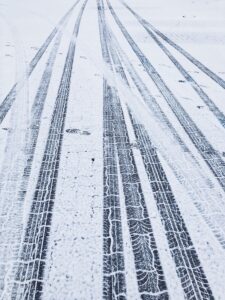
Tire track impressions are classified as pattern evidence because the tire track impressions leave behind a unique pattern. Just like shoe impressions can help narrow down, the brand, style and size, Tire tracks have the ability to do the same thing. Tire track impressions can attempt to be matched through searchable data bases that the manufacturer, the FBI or another agency has put together. These data bases help an investigator determine what type of tire left the impression, and what brand the tire is. After this is determined it can help narrow down what type of vehicle that the tire would be used for. Like most evidence, tire tracks can be used to help with the identification of the perpetrator by placing the suspect at the scene by matching the tires with the tires on the suspected vehicle.
It is difficult for two vehicles to leave the same tire mark. This is because as tires are used, the wear on the tires changes the impression pattern of the tire. An example would be a unique wearing of the outer edge of a tire because the alignment of the vehicle is off. This unique pattern is of great importance to the investigation because this pattern will only be present in the tire of the vehicle that was used. Sometimes a vehicle can easily be identified, for example, the vehicle can have different tires used on the same vehicle.
Tire impressions, like fingerprints are classified into the categories of visible, plastic and latent. Samples of the impressions can be collected in several ways. The first type of prints is visible prints. These prints are visible to the naked eye and can be collected by photography without the use of any special equipment such as powders. The next type of prints is plastic prints or three-dimensional prints, these prints can be collected by making a cast of the print. A cast of the print is made using a powdered stone material such as dental stone and water. Once the mixture dries, a three dimensional impression is made. The last type of prints isLatent prints, which are prints that are not visible to the naked eye. Latent prints are usually found on surfaces that are flat in nature, such as Sidewalks, roads or driveways. To collect this type of tire impression an electrostatic and a gelatin lifter dust print lifting device would most likely be used. An electrostatic dust print lifting device is a tool that electrostatically charges particles within dust or light soil . These particles are then transferred to a lifting film, such as the gelatin lifter. This method is best for collecting dry or dusty residue impressions on almost any surface. . A gelatin lifter is a rubber sheet that can lift impressions off of porous rough, textured and curved surfaces. A gelatin lifter could also be used to collect prints from the vehicle or from the scene. As with all evidence, these impressions must be preserved properly to avoid contamination. For comparison prints that have been taken, it is best to leave these prints on the vehicle. Samples from the crime scene should be packaged.
Back to Crime Library
|
|
|
